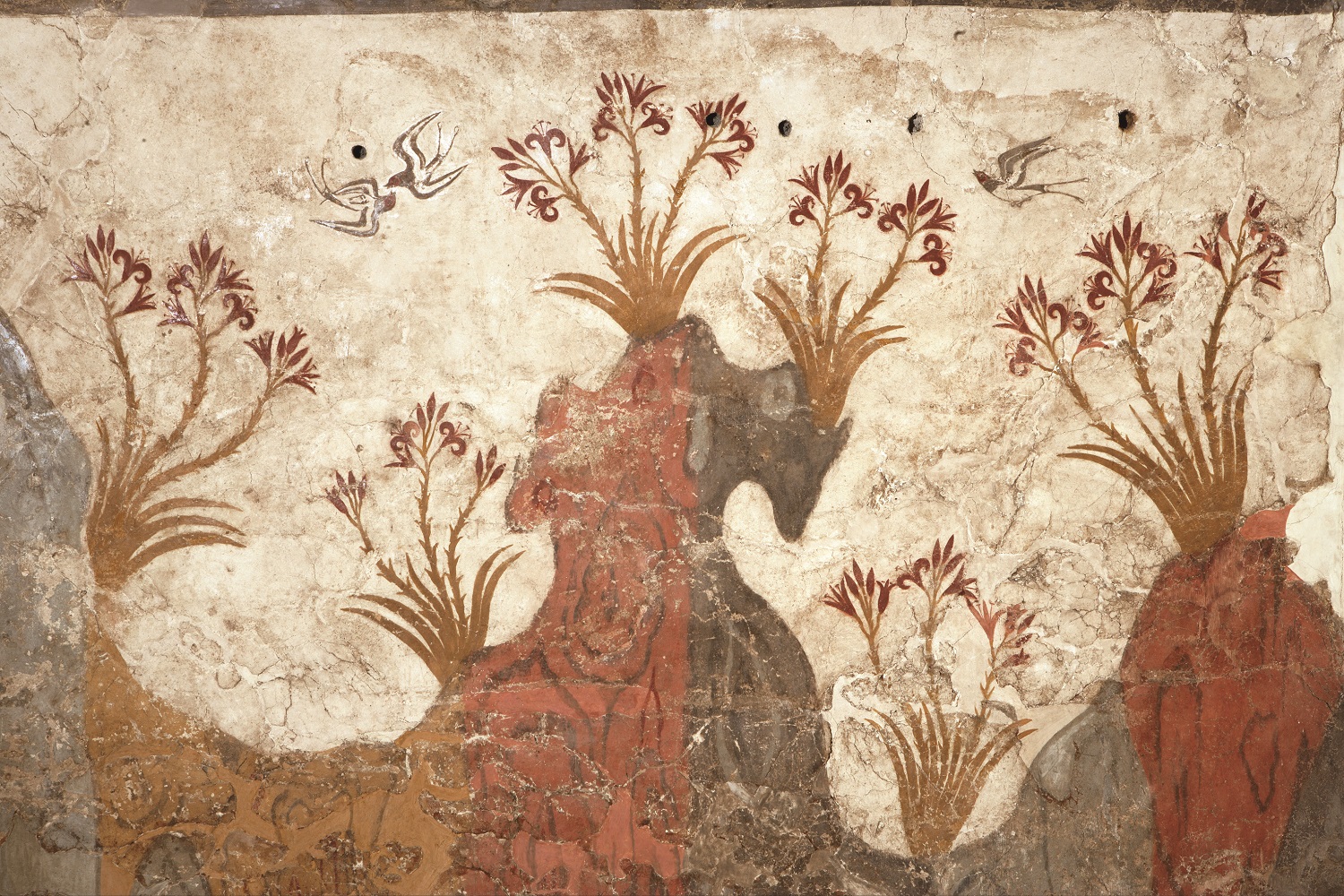Exhibit of the month
Flirtation in nature
The “Spring Fresco”
National Archaeological Museum
Collection of Prehistoric Antiquities, inv. no ΑΚΡ 1977.29
Provenance: Akrotiri, Thera, Delta Complex, Room D2
Date: 16th c. BC
Location of object within the exhibition: Prehistoric Antiquities of Thera, Room 48
In the heart of the excavated settlement of Akrotiri on Thera, on the ground floor of complex Delta is preserved the famous “Spring Fresco” that occupied three of the four walls of the small Room Delta 2[1]. Room D2 was one of the few decorated rooms of the complex and has been interpreted as a space intended for worship[2]. The uninterrupted wall painting depicts a fascinating landscape dominated by the colourful volcanic rock formations of Thera, embellished with blooming red lilies arranged in triads, while swallows fly in the sky. Unquestionably, the fresco depicts the advent of Spring in the Theran land, in March or April, when the flowers blossom and migratory birds return.
The natural protagonists amid the motionless landscape that decorated the small sanctuary are without doubt the seven swallows[3] three individual and two pairs, each one depicted in a unique manner. The swallow as a decorative motif was known in Cycladic pottery already since the Middle Bronze Age (2000-1600 BC). In this case, in the Late Cycladic I period of Akrotiri (circa 1600 BC), the painter introduces the motif into the monumental art of wall painting, rendering the birds with unprecedented vitality. It is certain that he has carefully observed the behaviour of the birds and has succeeded, by applying ingenious painterly solutions, in capturing the endless dynamics of a creature that flies restlessly in nature.
In the “Spring fresco” the flirtation of the swallows captivated inevitably the spectator’s gaze. “The two enamoured swallows chirp, standing almost erect” as the excavator Spyridon Marinatos characteristically describes. The image of the swallows that “communicate their affection in the air” constitutes a very rare depiction of flirtation in Aegean art, most likely symbolic and allusive to human relations, given that in the iconography of the 2nd millennium BC erotic scenes between humans are not explicitly illustrated. The representation of flirtatious pairs of birds or animals served as a tactful means to express love, the unavoidable attraction of the genders, the foreplay that signals the reproductive instinct which results in the creation of family. It is characteristic that in another fresco from Akrotiri that decorated room 4 of Xeste 3, the swallows are shown having already built their nests, taking care of their hatchlings.
Similar representations of bird flirtation are encountered in the Creto-Mycenaean art of seal engraving, whereas in one of the Vapheio cups, a bull is depicted standing next to a cow turning affectionately his head towards her. What is interesting in the “Spring fresco” is that the erotic element is suggested in a religious context, in a representation that symbolizes the rebirth of nature. Love is put forward as a hopeful message, as a natural expression, as the driving force for the continuation of life.
Dr Vasiliki Pliatsika
[1] The fourth wall of the room was left undecorated. It had a wooden door leading towards a court or a wide space and a large wooden-cased double window; both, when open, would offer a view of the fresco inside. One swallow pair was situated immediately across the door.
[2] From the moment it was discovered, room D2 was considered a sanctuary, where the fresco would constitute the backdrop for performing ritual actions. After the large earthquake that preceded the destructive explosion of the Thera volcano, the inhabitants filled the room with a large number of clay and bronze vessels, as well as a wooden bed, whose plaster cast is exhibited in the National Archaeological Museum, room 48.
[3] The swallows belong to the species Hirunda rustica rustic. The fresco painter added in their scissor-like tail two long feathers with circular ending, which do not actually appear on any swallow species, nor have they ever appeared, based on their natural evolution. This element was copied in other swallow depictions on frescoes and vases from Akrotiri, evidently under the influence of this particular fresco.
Suggested bibliography
Harte, K.J., “Birds of the Thera Wall Paintings”, στο Sherratt S. (επιμ.), The Wall Paintings of Thera, τ. ΙΙ, Athens 2000, 681-697.
Immerwahr, S.A., “Swallows and Dolphins at Akrotiri: Some Thoughts on the Relationship of Vase-Painting to Wall-Painting”, D.A. Hardy, C.G. Doumas, J.A. Sakellarakis, P.M. Warren (επιμ.), Thera and the Aegean World III, London 1990, 237-244.
Marinatos, N., Art and Religion in Thera. Reconstructing a Bronze Age Society, Athens 1984.
Marinatos, S., Excavations at Thera IV, Athens 1971.
Μαρινάτος, Σ., Θησαυροί της Θήρας, Αθήναι 1972.


